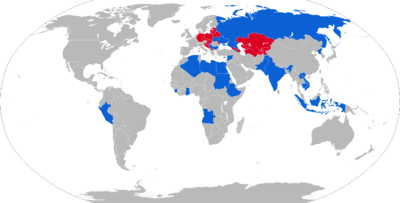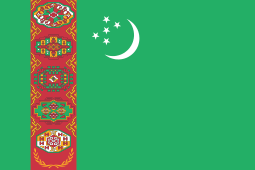9K34 Strela-3
| 9K34 Strela-3 | |
|---|---|
 A 9K34 Strela-3 (SA-14) missile and launch tube. | |
| Type | Man-portable air-defense systems (MANPADS) |
| Place of origin | Soviet Union |
| Service history | |
| In service | 1974–present |
| Used by | See Operators |
| Wars | Iran–Iraq War, War in Abkhazia (1992–1993), Bosnian War, Second Congo War, Afghan Civil War, Iraq War |
| Production history | |
| Manufacturer | KBM, Kolomna |
| Specifications | |
| Weight | Missile weight: 10.3 kilograms (23 lb), Full system: 16.0 kg (35.3 lb) |
| Length | 1.47 metres (4.8 ft) |
|
| |
Operational range | 4,100 m |
| Flight altitude | 2,300 metres (7,500 ft) |
| Speed | 410 metres per second (1,500 km/h; 920 mph) |
The 9K34 Strela-3 (Russian: 9К34 «Стрела-3», 'arrow', NATO reporting name: SA-14 Gremlin) is a man-portable air defense missile system (MANPADS) developed in the Soviet Union as a response to the poor performance of the earlier 9K32 Strela 2 (SA-7 Grail) system. The missile was largely based on the earlier Strela 2, and thus development proceeded rapidly. The new weapon was accepted into service in the Soviet Army in January 1974.
Description
The most significant change over the Strela 2 was the introduction of an all-new infra-red homing seeker head. The new seeker worked on FM modulation (con-scan) principle, which is less vulnerable to jamming and decoy flares than the earlier AM (spin-scan) seekers, which were easily fooled by flares and even the most primitive infrared jammers. The new seeker also introduced detector element cooling in the form of a pressurized nitrogen bottle attached to the launcher.
The effect of cooling was to expand the seeker's lead sulphide detector element's sensitivity range to longer wavelengths (slightly over 4 µm as opposed to 2.8 µm of uncooled PbS elements). In practice this made possible the tracking of cooler targets over longer ranges, and enabled forward-hemisphere engagement of jets under favourable circumstances. The seeker also had better tracking rate, enabling the missile to track maneuvering of fast and approaching targets.
A negative side effect from the aforementioned improvements was increased missile weight, which caused a slight decrease in the kinematic performance of the original Strela-2 (SA-7). Against relatively slow, low-altitude battlefield air threats the overall effectiveness was much improved.
Strela-3 missiles have been exported to over 30 countries.
The original Strela-3 missile was the 9M36. The follow-on to the Strela-3 was Igla.
The naval version of this missile has the NATO reporting name of SA-N-8.
Operational history
Iraq
On 22 November 2003 an Airbus A300 cargo plane was hit by a Strela-3 missile after takeoff from Baghdad International Airport, but managed to land safely despite losing hydraulic power.
On 6 May 2006, a British Westland Lynx AH.7 of the Royal Navy from 847 Squadron was shot down with a Strela-3 over Basra, killing five crewmen and crashing into a house.[1]
Abkhazia
During the War in Abkhazia (1992–1993), a Russian Mi-8 helicopter was shot down by a Georgian Army SA-14 on December 14, 1992, resulting in the death of 3 crew and 58 passengers, most of them Russian refugees. A Georgian Air Force Su-25 was shot down over Nizhnaya Eshera on 4 July 1993 by SA-14,[2] and several other aircraft on both sides may have been shot down by SA-14s.[3]
Former Yugoslavia
A British BAE Sea Harrier of 801 Naval Air Squadron, operating from aircraft carrier HMS Ark Royal, was shot down during its attack on two Serbian T-55 tanks in Bosnia. The pilot, Lieutenant Nick Richardson, ejected and landed in territory controlled by friendly Bosniaks (16 April 1994).
DRC Congo
A Zimbabwe Air Force Il-76 was shot down by Congolese rebels using an SA-14 on 11 October 1998 during the Second Congo War, resulting in the death of 40 troops and crew.[4]
Afghanistan
SA-14s used by the Northern Alliance are credited with having shot down 8 Taliban MiG-21 and Su-22 fighters during the Taliban's 2000 offensive against Taloqan.[5]
Operators

Current operators




































Former operators



.svg.png)


.svg.png)
Comparison chart
| System | 9K32M Strela-2M (missile: 9M32M) | 9K34 Strela-3 (missile: 9M36) [11] | FIM-43C Redeye[12] |
|---|---|---|---|
| Service entry | 1968 | 1974 | 1968 |
| Mass, full system, ready to shoot | 15 kg | 16 kg | 13.3 kg |
| Weight, missile | 9.8 kg | 10.3 kg | 8.3 kg |
| Length | 1.44 m | 1.47 m | 1.40 m |
| Warhead | 1.15 kg (0.37 kg HMX) directed-energy blast fragmentation | 1.17 kg (0.39 kg HMX) directed-energy blast fragmentation, including a 20g secondary charge to set off remaining rocket propellant | 1.06 kg M222 (0.36 kg HTA-3) blast fragmentation |
| Seeker type | AM-modulated (spin scan), uncooled PbS detector element (1–2.8 µm sensitivity range). Tail-chase only. | FM-modulated (con scan), nitrogen-cooled PbS detector element (2–4.3 µm sensitivity range). Limited forward hemisphere (all-aspect) capability | AM-modulated, uncooled PbS detector element. Tail-chase only. |
| Maximum range | 4,200 m | 4,100 m | 4,500 m |
| Speed | 430 m/s | 410 m/s | 580 m/s |
| Target's maximum speed, approaching/receding | 150/260 m/s | 310/260 m/s | –/225 m/s |
| Engagement altitude | 0.05–2.3 km | 0.03–2.3 km | 0.05–2.7 km |
See also
References
- ↑ http://www.aviationnewsreleases.com/2009/04/raf-pursues-common-das-demonstrator.html
- ↑ "{title}". Archived from the original on 2015-09-23. Retrieved 2013-04-20.
- ↑ Cooper, Tom. "Georgia and Abkhazia, 1992-1993: the War of Datchas". ACIG.org. Retrieved 18 February 2013.
- ↑ Cooper, Tom. "Zaire/DR Congo, 1980-2001". ACIG.org. Retrieved 18 February 2013.
- ↑ Cooper, Tom. "Afghanistan, 1979-2001; Part 2". ACIG.org. Retrieved 18 February 2013.
- 1 2 3 4 5 "Guided light weapons reportedly held by non-state armed groups 1998-2013" (PDF). Small Arms Survey. March 2013.
- 1 2 3 4 5 6 7 8 9 10 11 12 13 International Institute for Strategic Studies (IISS) (14 February 2018). "The Military Balance 2018". The Military Balance. 118.
- ↑ Cooper, Tom. "Georgia and Abkhazia, 1992-1993: the War of Datchas". ACIG.org. Retrieved 18 February 2013.
- ↑ Small Arms Survey (2012). "Blue Skies and Dark Clouds: Kazakhstan and Small Arms" (PDF). Small Arms Survey 2012: Moving Targets. Cambridge University Press. p. 131. ISBN 978-0-521-19714-4.
- 1 2 3 4
- ↑ Istorija sozdanija i razvitija vooruzhenija i vojennoi theniki PVO suhoputnyh voisk Rossii
- ↑ General Dynamics FIM-43 Redeye
Bibliography
- Petukhov, Sergei I.; Shestov I.V. (1998). History of design and development of missile systems and military systems of AAW of Russian Land Forces / Istorija sozdanija i razvitija vooruzhenija i vojennoi tehniki PVO suhoputnyh voisk Rossii, 1.-2. VPK Publishing.
- "Directory of U.S. Military Rockets and Missiles, FIM-43". Archived from the original on 17 April 2008. Retrieved 2008-04-23.
External links
| Wikimedia Commons has media related to Strela-3. |